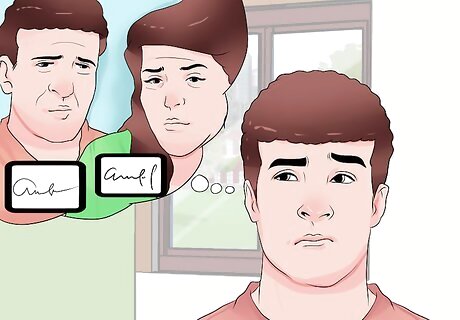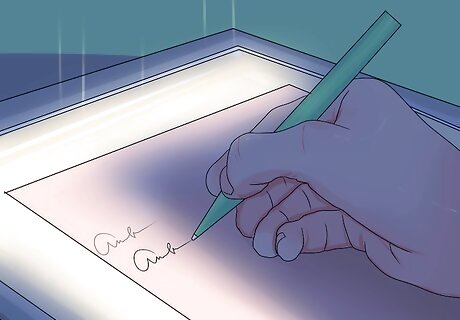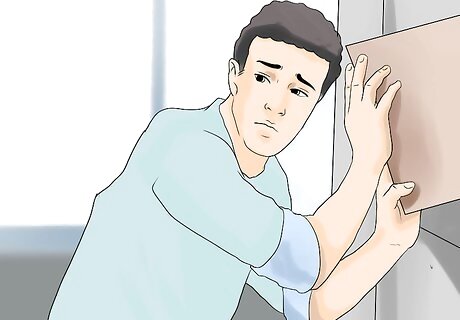
views
X
Research source
This should be considered a mere study in how a parent's signature may be forged, as actually forging a signature will certainly cause problems with your parents, your school (if you forge a signature for a school form), and possibly with the law.
Creating a Simulated Signature

Choose a parent. Assuming that you have access to both parents' signatures, the first step will be to choose which parent's signature to forge. Studies have shown that there are detectable differences between male and female handwriting. Therefore, it may be easier to fake a signature of the parent who is the same gender as you, if applicable.

Study a signature sample. Once you've chosen which parent to copy, you'll need a sample of that parent's signature. You probably have many basic handwriting samples of that parent lying around the house, but you need an actual signature. Try looking for a personal check your parent has written for someone, or a receipt he or she has signed. Observe your parent's letter stylings, proportions, and height ratios. These are the parts of a signature that are often neglected when someone forges another person's signature, and it makes it much easier to catch the forgery. Look for signs of your parent's pen starts and stops, as these can also be telling markers of an authentic vs. a forged signature.

Practice the signature. Keep your parent's authentic signature close at hand and practice replicating it on a blank, disposable sheet of scrap paper. Pay close attention to the form of each letter, whether the pen is ever lifted (and if so, where), and the overall hand movement suggested by the signature. Compare your practice signatures with the real thing. Keep practicing until you achieve a nearly identical replica. As you practice your parent's signature, compare the size and length of the two signatures. Most people use the same amount of space to sign their name, no matter what document is being signed. If your replica signature is noticeably bigger or smaller than your parent's, it will be pretty easy to identify as a fake.

Sign the real document. Once you've adequately practiced your chosen parent's signature and can make a convincing replica, you're ready to move on to the actual signature. Before you put pen to paper, however, you should be aware of the ways in which even a studied signature could be identified as fake. Hold the pen comfortably. A common trait among people forging a signature is to grip the pen with a tight fist out of nervousness and/or concentration. This produces a very rigid signature, which can easily be identified as a counterfeit. If you must look up to re-examine the actual signature at any point, do not hold the pen to the page. This produces a blot of ink that can be a very obvious sign of forgery. Likewise, try to avoid breaking the signature (to re-examine the original) between letters or in mid-letter. A sudden change in the signature in which the pen was obviously lifted from the page is a tell-tale mark of a forged signature. Aim to replicate the entire first name in one smooth run, then the entire last name in one continuous signature.

Hide the evidence. Once you've signed the document, hide it in a place that your parents will not see it. If you signed your father's name and he sees a document that he has never seen before with "his" signature on it, he will immediately know something is not right. You should also return your parent's original signature to the location where you found it. Lastly, be sure to destroy the practice pages you used to learn your parent's signature. Any sign of a sheet of paper with dozens of signatures on it will quickly tip off your parent that you've forged something in his/her name.
Tracing a Signature

Choose a parent's signature. Assuming you have both parents' signatures to choose from, you'll need to decide on a parent whose signature you will replicate. Unlike the simulated signature, tracing will aim to recreate the signature by simply reproducing the authentic signature, so your gender and your parent's gender won't matter.

Find a sample signature. Once you've chosen a parent whose signature you will trace, you'll need to find a written sample of that parent's signature. Look for something your parent would need to sign his or her official signature on, such as a personal check, a receipt, or some official document. If at all possible, find something with a dark, bold signature. This will make it easier to trace that signature through whatever page you will be signing. Be aware that tracing a signature may leave a second line of ink, or at least an indentation, on your parent's original signature. This evidence will be impossible to conceal, and may even invalidate whatever document your parent initially signed. Use great caution when selecting a signature to trace so that you do not ruin any important documents or leave behind any obvious evidence.

Align the two documents and backlight them. The easiest way to trace another person's signature is by aligning the signature line of the un-signed document directly over a sample of the authentic signature. You can do this easily by securing the two documents in place with a paperclip on each side of the document. Be sure that the paperclip extends to cover all four edges of both pieces of paper. Once the real signature is aligned under the blank signature line on the un-signed document, you'll need to provide a source of light behind or under the authentic document. You can do this by holding the two papers (tightly secured to one another) over a lamp shade or on a window (assuming it's light out). The backlighting is necessary to allow you to see the authentic signature under the un-signed document. Otherwise, unless the un-signed document is printed on thin tracing paper, you will have a very hard time tracing the signature.

Trace your parent's signature. As you backlight the two pages, slowly and carefully trace your parent's signature onto the un-signed document. The traced signature has the advantage of being 100% identical to your parent's, so the height, ratios/proportions, and line starts/stops will look identical.

Return the original signature. Once you've finished replicating your parent's signature, you'll need to return the original to wherever you found it. If your parent comes into your room and sees a check, receipt, or other document bearing his/her signature lying around, it will be very clear that you're doing something you're not supposed to do.
Scanning a Signature

Find a parent's signature. If you have access to a computer with a scanner, photo-editing software, and a printer, you can scan a parent's signature into the computer and print it onto the document that needs to be signed. Before you can scan anything, though, you'll need to choose a parent and find a piece of paper with that parent's signature.

Scan the signature. Place the authentic signature into your computer's scanner and save the image as a PDF. Before you click save, however, you'll need to crop the signature to an accurate size. You can play around with the size by enlarging or shrinking as needed, and doing a test print of just the signature to see how it comes out on paper. Choose a name for the saved PDF that will be easy for you to identify but will not be obvious to your parents, should they see your desktop or documents folder.

Configure the graphic. If you're using Adobe, you'll need to go to the "Configure Graphic" tab and choose the "Imported Graphic" button. This should make the File button visible. Click File to finish configuring the graphic so that it can be inserted into a document. If you are not using Adobe, you can skip this step. Navigate to the "Select Picture" dialogue box and open the PDF you saved of your parent's signature. Then go back to "Configure Signature Appearance". You can make some fine-tuning edits to the signature under "Text Properties," or deselect all the boxes under "Configure Text" to create a more accurate digital image of your parent's signature.

Scan and "sign" document. The easiest way to print the now-scanned signature onto the un-signed document is to also scan the document and insert the signature into that image. Otherwise, you can make copies of the document and put them into the printer, but it will take a lot of trial and error to align the scanned signature in the proper place on the document. Once the document is signed, you can import the signature. Either edit it in with the editing software, or use the digital signature function, depending on the software you have at your disposal. If the signature looks good and is in the right place, print it out and see how it looks on paper. Make any adjustments you need to on the computer and re-print as necessary.

Hide the evidence. Return your parent's signature to wherever you found it. You should also remember to destroy any printed copies of the "signed" document that you will not be using.
Using a Pantograph

Buy a pantograph. A pantograph is a crude copying device used to create duplicate documents or signatures. Thomas Jefferson used a version of the pantograph, called a polygraph, to create a second copy of every letter he wrote. Similar machines/devices are variously called auto-pens or writing machines, and produce an identical signature when perfectly traced over an authentic signature. You can buy a pantograph online, or build your own by connecting two pens by a straight piece of wood or plastic, though a purchased pantograph will probably be more accurate.

Find and trace a signature. The beauty of a pantograph is that it will create a perfect replica of any signature you create. For the purposes of forging a parent's signature, however, you can also trace over an existing signature to create an identical duplicate. You may want to take the ink cartridge out of the tracing pen so that it does not draw over your parent's existing signature, or use a signature that is not important and can be discarded (like a credit card receipt from an insignificant purchase). Try tracing the signature onto a blank scrap of paper before you attempt to "sign" the actual document. This will ensure that you get the signature's motion and fluidity down correctly.

Hide the original signature. If you borrowed a check, receipt, or document to trace your parent's signature, it's important that you return it where you found it. Be sure that your tracing does not invalidate any important documents, and use caution to cover your tracks.




















Comments
0 comment